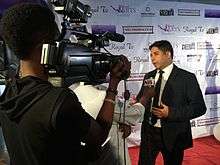Interview
An interview is essentially a structured conversation where one participant asks questions, and the other provides answers.[1] In common parlance, the word "interview" refers to a one-on-one conversation between an interviewer and an interviewee. The interviewer asks questions to which the interviewee responds, usually so information is offered by the interviewee to interviewer -- and that information may be used or provided to other audiences, whether in real time or later. This feature is common to many types of interviews -- a job interview or interview with a witness to an event may have no other audience present at the time, but the answers will be later provided to others in the employment or investigative process.
.jpg)



An interview may also transfer "information" or answers in both directions.
Interviews usually take place face-to-face and in person. In some, the parties are separated geographically, connecting by methods such as videoconferencing[2] or telephone interviews. Interviews almost always involve spoken conversation between two or more parties. In some instances a "conversation" can happen between two persons who type their questions and answers.
Interviews can be unstructured, free-wheeling and open-ended conversations without predetermined plan or prearranged questions,[3] or highly structured conversations in which specific questions occur in a specified order.[4] They can follow diverse formats; for example, in a ladder interview, a respondent's answers typically guide subsequent interviews, with the object being to explore a respondent's subconscious motives.[5][6] Typically the interviewer has some way of recording the information that is gleaned from the interviewee, often by keeping notes with a pencil and paper, or with a video or audio recorder. Interviews usually have a limited duration, with a beginning and an ending.
The traditional two-person interview format, sometimes called a one-on-one interview, permits direct questions and followups, which enables an interviewer to better gauge the accuracy and relevance of responses. It is a flexible arrangement in the sense that subsequent questions can be tailored to clarify earlier answers. Further, it eliminates possible distortion due to other parties being present.
Face to face interviewing helps both parties to interact and form a connection, and understand the other.[7] Further, face to face interview sessions can be more enjoyable.[7]
Contexts
Interviews can happen in a wide variety of contexts:
Employment. Interviews in an employment context are typically called job interviews which describe a formal consultation for the purpose of evaluating the qualifications of the interviewee for a specific position.[8] Interviews are seen as a useful tool in assessing qualifications.[9] A specific type of job interview is a case interview in which the applicant is presented with a question or task or challenge, and asked to resolve the situation.[10] Sometimes to prepare for job interviews, candidates are treated to a mock interview as a training exercise to prepare the respondent to handle questions in the subsequent 'real' interview. Sometimes the interviews happen in several waves, with the first interview sometimes being called a screening interview which is a shorter length interview, followed by more in-depth interviews later on, usually by company personnel who can ultimately hire the applicant. Technology has enabled new possibilities for interviewing; for example, video phoning technology has enabled applicants to interview for jobs despite being in different cities or countries than the interviewer.
Psychology. Psychologists use a variety of interviewing methods and techniques to try to understand and help their patients. In a psychiatric interview, a psychiatrist or psychologist or nurse asks a battery of questions to complete what is called a psychiatric assessment. Sometimes two people are interviewed by an interviewer, with one format being called couple interviews.[11] Criminologists and detectives sometimes use cognitive interviews on eyewitnesses and victims to try to ascertain what can be recalled specifically from a crime scene, hopefully before the specific memories begin to fade in the mind.[12][13]
Research. In marketing research and academic research, interviews are used in a wide variety of ways as a method to do extensive personality tests. Interviews are often used in qualitative research in which firms try to understand how consumers think. Consumer research firms sometimes use computer-assisted telephone interviewing to randomly dial phone numbers to conduct highly structured telephone interviews, with scripted questions and responses entered directly into the computer.[14]
Journalism and other media. Typically, reporters covering a story in journalism conduct interviews over the phone and in person to gain information for subsequent publication. Reporters also interview government officials and political candidates for broadcast.[15] In a talk show, a radio or television "host" interviews one or more people, with the topic usually chosen by the host, sometimes for the purposes of entertainment, sometimes for informational purposes. Such interviews are often recorded.
Other situations. Sometimes college representatives or alumni conduct college interviews with prospective students as a way of assessing a student's suitability while offering the student a chance to learn more about a college.[16] Some services specialize in coaching people for interviews.[16] Embassy officials may conduct interviews with applicants for student visas before approving their visa applications. Interviewing in legal contexts is often called interrogation. Debriefing is another kind of interview.
Blind interview
In a blind interview the identity of the interviewee is concealed so as to reduce interviewer bias. Blind interviews are sometimes used in the software industry and are standard in orchestral auditions. Blind interviews have been shown in some cases to increase the hiring of minorities and women.[17]
Interviewer bias
The relationship between the interviewer and interviewee in research settings can have both positive and negative consequences.[18] Their relationship can bring deeper understanding of the information being collected, however this creates a risk that the interviewer will be unable to be unbiased in their collection and interpretation of information[18]. Bias can be created from the interviewers perception of the interviewee, or from the interviewee's perception of the interviewer[18]. Additionally, a researcher can bring biases to the table based on the researcher’s mental state, their preparedness for conducting the research, and the researcher conducting inappropriate interviews.[19] Interviewers can use various practices known in qualitative research to mitigate interviewer bias. These practices include subjectivity, objectivity, and reflexivity. Each of these practices allows the interviewer, or researcher, the opportunity to use their bias to enhance their work by gaining a deeper understanding of the problem they are studying.[20]
See also
- Repertory grid interview
- In research
- Telephone interview
- Computer assisted telephone interviewing
- Interview (research)
- Knowledge transfer
- Online interview
- Mall intercept interview
- Qualitative research interview
- Structured interview
- Unstructured interview
- In journalism and media
- In other contexts
- College interview
- Reference interview, between a librarian and a library user
References
- Merriam Webster Dictionary, Interview, Dictionary definition, Retrieved February 16, 2016
- "Introduction to Interviewing". Brandeis University. Retrieved 2015-05-02.
- Rogers, Carl R. (1945). Frontier Thinking in Guidance. University of California: Science research associates. pp. 105–112. Retrieved March 18, 2015.
- Kvale & Brinkman. 2008. InterViews, 2nd Edition. Thousand Oaks: SAGE. ISBN 978-0-7619-2542-2
- 2009, Uxmatters, Laddering: A research interview technique for uncovering core values
- "15 Tips on How to Nail a Face-to-Face Interview". blog.pluralsight.com. Retrieved 2015-11-05.
- Snap Surveys, Advantages and disadvantages of face to face data collection, Retrieved April 27, 2018
- Dipboye, R. L., Macan, T., & Shahani-Denning, C. (2012). The selection interview from the interviewer and applicant perspectives: Can't have one without the other. In N. Schmitt (Ed.), The Oxford handbook of personnel assessment and selection (pp. 323-352). New York City: Oxford University.
- "The Value or Importance of a Job Interview". Houston Chronicle. Retrieved 2014-01-17.
- Maggie Lu, The Harvard Business School Guide to Careers in Management Consulting, 2002, page 21, ISBN 978-1-57851-581-3
- Polak, L; Green, J (2015). "Using Joint Interviews to Add Analytic Value". Qualitative Health Research. 26 (12): 1638–48. doi:10.1177/1049732315580103. PMID 25850721.
- Memon, A., Cronin, O., Eaves, R., Bull, R. (1995). An empirical test of mnemonic components of the cognitive interview. In G. Davies, S. Lloyd-Bostock, M. McMurran, C. Wilson (Eds.), Psychology, Law, and Criminal Justice (pp. 135-145). Berlin: Walter de Gruyer.
- Rand Corporation. (1975) The criminal investigation process (Vol. 1-3). Rand Corporation Technical Report R-1776-DOJ, R-1777-DOJ, Santa Monica, CA
- "BLS Information". Glossary. U.S. Bureau of Labor Statistics Division of Information Services. February 28, 2008. Retrieved 2009-05-05.
- Beaman, Jim (2011-04-14). Interviewing for Radio. Routledge. ISBN 978-1-136-85007-3.
- Sanjay Salomon (January 30, 2015). "Can a Failure Resume Help You Succeed?". Boston Globe. Retrieved January 31, 2016.
...A 'failure resume' is ... a private exercise ... outline what they learned from the experience ... Mark Efinger is president and founder of Interview Skill Coaching Academy in Great Barrington, where he prepares candidates for the job interview experience. ...
- Miller, Claire Cain (25 February 2016). "Is Blind Hiring the Best Hiring?". The New York Times.
- Watson, Lucas (2018). Qualitative research design : an interactive approach. New Orleans. ISBN 978-1-68469-560-7. OCLC 1124999541.
- Chenail, Ronald (2011-01-01). "Interviewing the Investigator: Strategies for Addressing Instrumentation and Researcher Bias Concerns in Qualitative Research". The Qualitative Report. 16 (1): 255–262. ISSN 1052-0147.
- Roulston, Kathryn; Shelton, Stephanie Anne (2015-02-17). "Reconceptualizing Bias in Teaching Qualitative Research Methods". Qualitative Inquiry. 21 (4): 332–342. doi:10.1177/1077800414563803. ISSN 1077-8004.